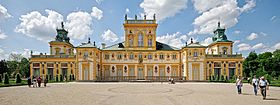Wilanów Palace
| Wilanów Palace | |
|---|---|
| pałac w Wilanowie | |

View of the façade from the royal gardens
|
|
|
Location within Poland
|
|
| General information | |
| Type | Palace |
| Architectural style | Baroque |
| Location | Warsaw, Poland |
| Country | Poland |
| Coordinates | 52°9′55″N 21°5′25″E / 52.16528°N 21.09028°E |
| Current tenants | Wilanów Palace Museum |
| Construction started | April 23, 1677 |
| Completed | 1696 |
| Client | John III Sobieski |
| Owner | John III Sobieski sons Elżbieta Sieniawska Augustus II the Strong Maria Zofia Czartoryska Izabela Lubomirska Ksawery Branicki Adam Branicki National Museum in Warsaw (last owner) |
| Design and construction | |
| Architect | Augustyn Wincenty Locci |
| Website | |
| Official Website | |
Wilanów Palace or Wilanowski Palace (Polish: pałac w Wilanowie, Polish pronunciation: [ˈpawat͡s vvilaˈnɔvjɛ]) is a royal palace located in the Wilanów district, Warsaw. Wilanów Palace survived Poland's partitions and both World Wars, and so serves as a reminder of the culture of the Polish state as it was before the misfortunes of the 18th century.
It is one of Poland's most important monuments. The Palace's museum, established in 1805, is a repository of the country's royal and artistic heritage. The palace and park in Wilanów hosts cultural events and concerts, including Summer Royal Concerts in the Rose Garden and the International Summer Early Music Academy.
The palace, together with other elements of Warsaw Old Town, is one of Poland's official national Historic Monuments (Pomnik historii), as designated September 16, 1994. Its listing is maintained by the National Heritage Board of Poland.
Since 2006, the palace has been a member of the international association of European Royal Residences.
Wilanów Palace was built for king John III Sobieski in the last quarter of the 17th century and later was enlarged by other owners. It represents the characteristic type of baroque suburban residence built entre cour et jardin (between the entrance court and the garden). Its architecture is original, a merger of generally European art with distinctively Polish building traditions. Upon its elevations and in the palace interiors ancient symbols glorify the Sobieski family, especially the military triumphs of the king.
...
Wikipedia

